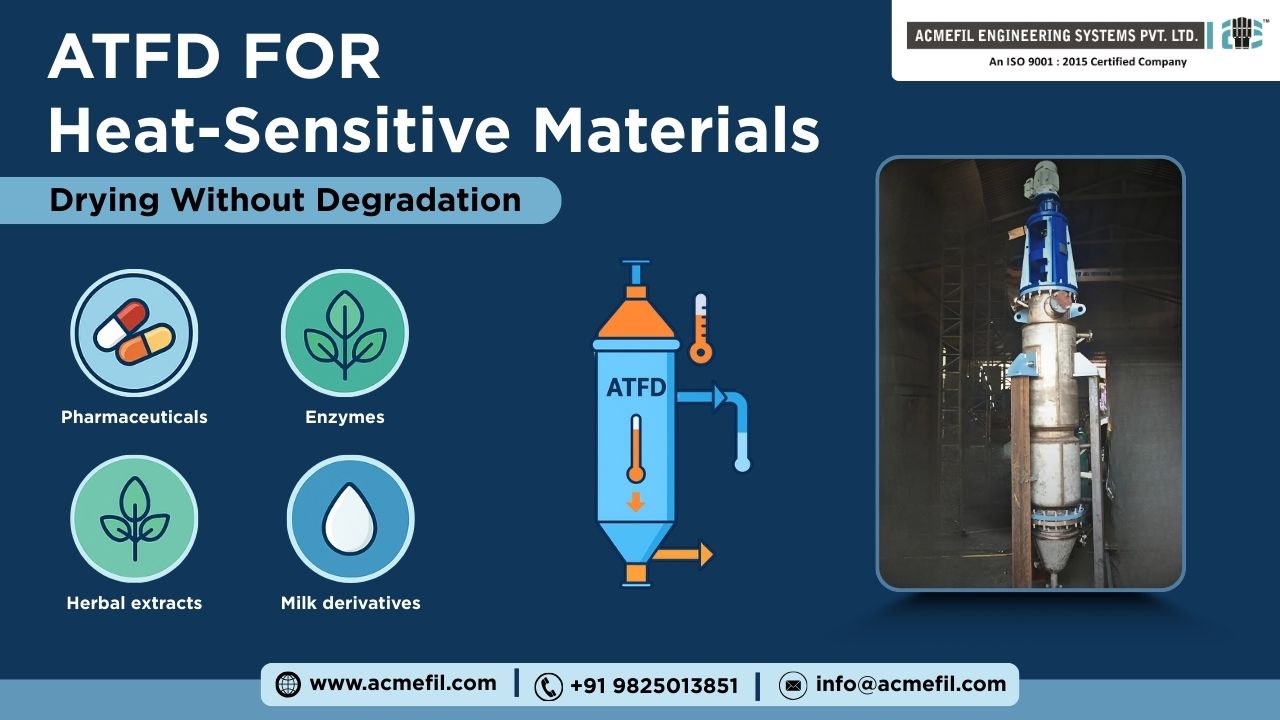Did you know that up to 40% of heat-sensitive materials can be damaged during conventional drying processes, resulting in millions of dollars in product waste annually? This startling statistic highlights why selecting the right drying technology is critical for manufacturers working with thermally vulnerable substances. If you’re handling heat-sensitive materials, Agitated Thin Film Dryers (ATFD) might be the solution you’ve been searching for. This comprehensive guide explores how ATFDs are revolutionizing the processing of temperature-sensitive products across multiple industries.
What is an Agitated Thin Film Dryer (ATFD)?
An Agitated Thin Film Dryer represents cutting-edge drying technology specifically engineered for materials that cannot withstand prolonged exposure to high temperatures. Unlike conventional dryers that may subject products to excessive heat for extended periods, ATFDs operate on a fundamentally different principle that preserves product integrity while achieving efficient drying.
The Working Principle of ATFD Technology
ATFDs function by creating an extremely thin film of product material (typically 0.5-2mm thick) across a heated surface. This is accomplished through a sophisticated rotor system with precision-engineered blades that continuously agitate and spread the material. The key advantages of this approach include:
- Minimal Thermal Exposure: The product experiences high heat transfer rates but extremely short residence times (typically seconds to minutes)
- Uniform Heat Distribution: The mechanical agitation ensures consistent heating across all material particles
- Continuous Operation: Most ATFDs operate as continuous rather than batch processes, improving production efficiency
- Vacuum Capability: Many ATFDs operate under vacuum conditions, further reducing the boiling point of solvents and allowing for even lower processing temperatures
This unique combination of features makes ATFD technology particularly valuable for processing heat-sensitive materials that would degrade, discolor, or lose efficacy when subjected to conventional drying methods.
Why Heat-Sensitive Materials Need Special Drying Technology
Heat sensitivity in materials can manifest in several ways, all of which can compromise product quality:
- Chemical Degradation: Breaking of molecular bonds leading to altered properties
- Loss of Bioactivity: Reduction or elimination of enzymatic or biological functions
- Color Changes: Unwanted browning, yellowing, or discoloration
- Texture Alterations: Undesirable hardening, softening, or structural changes
- Nutritional Losses: Reduction in vitamin content or other beneficial compounds
Conventional drying technologies often force manufacturers to choose between adequate drying and maintaining product quality. ATFDs eliminate this difficult tradeoff by providing efficient moisture removal while minimizing thermal damage.
7 Key Industries Benefiting from ATFD Applications
1. Pharmaceutical Industry
The pharmaceutical sector perhaps benefits most dramatically from ATFD technology. When processing active pharmaceutical ingredients (APIs) and other medicinal compounds, maintaining molecular integrity is non-negotiable.
Critical Applications:
- API Processing: Many active pharmaceutical ingredients are temperature-sensitive and require precise drying conditions
- Vaccine Components: Biological materials used in vaccine production often cannot withstand prolonged heating
- Peptides and Proteins: These complex molecules can denature and lose functionality at elevated temperatures
- Controlled-Release Formulations: Specialized coating materials must maintain specific properties
A major European pharmaceutical manufacturer reported reducing product degradation by 78% after switching from conventional tray drying to ATFD technology for a temperature-sensitive antibiotic intermediate.
2. Food and Beverage Processing
Consumer expectations for natural flavors, colors, and nutritional value have made gentle drying technologies increasingly important in food processing.
Key Applications:
- Natural Flavor Extracts: Preserving volatile aromatics that would be lost in conventional dryers
- Fruit and Vegetable Concentrates: Maintaining color, flavor, and nutritional properties
- Dairy Products: Processing heat-sensitive milk proteins and derivatives
- Nutritional Supplements: Preserving active compounds like probiotics and enzymes
Studies show that fruit juice concentrates processed via ATFD retain up to 95% of their vitamin C content compared to just 60% when using conventional evaporators.
3. Fine Chemical Production
The fine chemicals industry produces high-value, specialized compounds that often have strict quality parameters.
Notable Applications:
- Specialty Polymers: Maintaining precise molecular weight distributions
- Catalysts: Preserving active surface properties and preventing sintering
- Intermediates for Agrochemicals: Ensuring stability of active compounds
- Custom Synthesis Products: Meeting exacting client specifications
One specialty chemical producer documented a 40% increase in product value after implementing ATFD technology by eliminating heat-induced color formation in their final product.
4. Biotechnology Products
The biotech industry works with some of the most sensitive materials, including living cells and complex biological molecules.
Common ATFD Uses:
- Enzyme Preparations: Maintaining catalytic activity through gentle drying
- Cell Culture Media Components: Preserving growth factors and nutrients
- Recombinant Proteins: Preventing denaturation during concentration steps
- Bacterial and Yeast Extracts: Retaining bioactivity of cellular components
A leading enzyme manufacturer credits ATFD technology with enabling a 35% increase in specific enzyme activity in their final dried product compared to previous drying methods.
5. Cosmetics and Personal Care
Modern cosmetic formulations often incorporate delicate natural ingredients that require careful processing.
Important Applications:
- Natural Extracts: Preserving active botanical compounds
- Hyaluronic Acid and Collagen: Maintaining molecular integrity of these skin-beneficial ingredients
- Liposomal Preparations: Ensuring vesicle structure remains intact
- Vitamin-Enriched Formulations: Preventing oxidation and degradation
The gentle drying conditions provided by ATFDs have allowed cosmetic manufacturers to increase the concentration of natural actives in their products while extending shelf life.
6. Nutraceuticals and Health Supplements
The growing nutraceutical industry relies heavily on preserving the biological activity of natural ingredients.
Key Areas:
- Herbal Extracts: Concentrating active compounds without degradation
- Probiotic Formulations: Maintaining viable bacterial counts
- Omega Fatty Acid Products: Preventing oxidation and rancidity
- Phytochemical Concentrates: Preserving delicate plant compounds
A case study from a major supplement manufacturer showed that switching to ATFD technology increased the measurable antioxidant activity in their green tea extract by 65%.
7. Environmental and Waste Processing
An emerging application for ATFD technology involves processing environmental samples and waste materials.
Innovative Uses:
- Concentration of Industrial Effluents: Reducing waste volume while preserving characteristics for analysis
- Recovery of Valuable Components from Waste Streams: Capturing heat-sensitive compounds from byproducts
- Soil Remediation Sample Preparation: Maintaining volatile contaminants for accurate analysis
- Sludge Processing: Reducing moisture content while preventing odor formation
Technical Advantages of ATFDs for Heat-Sensitive Applications
Precision Temperature Control
ATFDs offer exceptional temperature control capabilities that prove crucial when processing heat-sensitive materials:
- Narrow Temperature Gradients: Temperature differences across the product film typically stay within 2-5°C
- Rapid Adjustability: System temperatures can be quickly modified to accommodate different products
- Localized Heating: Only the heat transfer surface reaches elevated temperatures, not the entire system
- Temperature Sensing: Advanced models incorporate multiple temperature sensors for continuous monitoring
Optimized Residence Time
Minimizing the time that heat-sensitive materials spend exposed to elevated temperatures is a fundamental advantage of ATFD systems:
- Short Contact Periods: Typical residence times range from just 20-120 seconds
- Continuous Flow: Product moves steadily through the system without “dead zones” where material might stagnate
- Adjustable Throughput: Feed rates can be calibrated to optimize the residence time for specific products
- Controlled Progression: The rotor system ensures methodical movement of material through the dryer
Enhanced Mass Transfer
Efficient removal of moisture or solvents is facilitated by several design elements:
- High Surface Area Exposure: The thin film maximizes the product surface area exposed to the vacuum
- Turbulent Flow Patterns: The agitation creates turbulence that enhances mass transfer
- Vapor Removal Pathways: System design facilitates rapid removal of evolved vapors
- Vacuum Integration: Operating under reduced pressure further accelerates the mass transfer process
Optimizing ATFD Operation for Heat-Sensitive Materials
Critical Process Parameters
When working with heat-sensitive materials, several operational parameters require careful attention:
- Feed Rate: Must be calibrated to ensure optimal film thickness
- Rotor Speed: Affects film formation, residence time, and heat transfer efficiency
- Jacket Temperature: Should be set at the minimum effective level for the specific product
- Vacuum Level: Higher vacuum allows lower operating temperatures
- Feed Pre-Conditioning: Proper pre-treatment can reduce required drying intensity
Common Challenges and Solutions
Even with advanced ATFD technology, processors may encounter challenges that require troubleshooting:
| Challenge | Solution |
|---|---|
| Product Fouling on Heat Surface | Adjust blade clearance; modify rotor design; implement specialized coatings |
| Inconsistent Film Formation | Review feed viscosity; adjust rotor speed; examine feed distribution system |
| Residual Moisture Content | Evaluate vacuum system efficiency; consider condensing system upgrades |
| Product Discoloration | Reduce jacket temperature; add antioxidants where applicable; minimize oxygen exposure |
| Scale-Up Difficulties | Conduct pilot tests; work with experienced equipment manufacturers |
Future Trends in ATFD Technology for Heat-Sensitive Materials
The evolution of ATFD technology continues to expand its capabilities for processing delicate substances:
Material Innovations
- Advanced Surface Coatings: New fluoropolymer and ceramic composites are extending equipment life while reducing product adhesion
- Novel Blade Designs: Computational fluid dynamics is enabling more efficient blade geometries
- Specialized Alloys: Metallurgical advances are creating heat transfer surfaces with superior thermal properties
Process Control Enhancements
- Real-Time Analytics: Integration of NIR and Raman spectroscopy for continuous product monitoring
- AI-Driven Optimization: Machine learning algorithms that continuously adjust parameters based on product characteristics
- Digital Twins: Virtual simulations that predict performance under varying conditions
Hybrid Systems
- ATFD-Microwave Combinations: Supplementing conductive heating with targeted microwave energy
- Ultrasonic Assistance: Adding vibrational energy to enhance mass transfer
- Multi-Stage Configurations: Sequential processing under progressively changing conditions
Selecting the Right ATFD System for Your Heat-Sensitive Application
When evaluating ATFD technology for specific heat-sensitive materials, consider these key factors:
Material Characteristics Assessment
- Thermal Sensitivity Profile: Determine the exact temperature thresholds where degradation begins
- Physical Properties: Viscosity, particle size, and adhesion tendencies affect equipment selection
- Chemical Compatibility: Ensure all wetted parts are compatible with your product and cleaning agents
- Scale Requirements: Current production needs and future expansion possibilities
Equipment Design Considerations
- Heat Transfer Surface Area: Must be adequate for required throughput
- Rotor Configuration: Different blade designs suit various product types
- Materials of Construction: Options range from standard stainless steel to exotic alloys
- CIP/SIP Capabilities: Essential for pharmaceutical and food applications
- Control Systems: Look for systems offering precise parameter control and data logging
Vendor Evaluation
- Testing Capabilities: Ability to conduct meaningful pilot-scale trials
- Industry Experience: Previous success with similar applications
- Engineering Support: Expertise in system integration and optimization
- Service Network: Available technical support in your operational regions
- Regulatory Understanding: Familiarity with relevant industry standards (GMP, ASME, etc.)
Conclusion: Maximizing the Value of ATFD Technology for Heat-Sensitive Processing
The application of Agitated Thin Film Dryers represents a significant advancement in the processing of heat-sensitive materials across multiple industries. By precisely controlling temperature exposure, minimizing residence time, and optimizing mass transfer, ATFDs enable manufacturers to preserve critical product attributes while achieving efficient moisture removal.
As we’ve explored throughout this comprehensive guide, the benefits extend far beyond simple drying—ATFDs can improve product quality, increase yields, reduce energy consumption, and enable the processing of previously problematic materials. Whether you’re working in pharmaceuticals, food processing, fine chemicals, or any other field involving thermally sensitive substances, ATFD technology merits serious consideration.
The future of heat-sensitive material processing will likely see continued refinement of ATFD technology, with smarter controls, more durable materials, and hybrid configurations expanding the already impressive capabilities of these sophisticated systems.
Acmefil: Engineering Excellence in Thin Film Drying Technology
Acmefil Engineering Systems Pvt. Ltd., an ISO 9001:2015 certified Indian company established in 1992, stands at the forefront of advanced industrial drying technology with its state-of-the-art Agitated Thin Film Dryer systems. The Acmefil ATFD units combine precision engineering with innovative design features that maximize heat transfer efficiency while minimizing product thermal exposure—ideal for pharmaceutical, food, and chemical manufacturers processing heat-sensitive materials. With over 800 installations nationwide and comprehensive turnkey solutions from design through commissioning, Acmefil delivers not just equipment but measurable improvements in product quality, yield, and operational efficiency that create lasting competitive advantages for their clients.


